Highlights
America’s birth rate is falling far below what is needed to maintain economic growth, and below what women themselves say they want. But while this demographic decline is easy enough to describe, solutions are harder to come by. Quick policy fixes, like more parental leave or financial incentives, may have some effect but are likely to be quite expensive relative to their modest impact on birth rates.
A large part of the decline in birth rates can be directly accounted for by a factor unlikely to be influenced by those birth-targeted incentives: marriage. That is, most long-run change in fertility can be accounted for by changes in the marital composition of society.
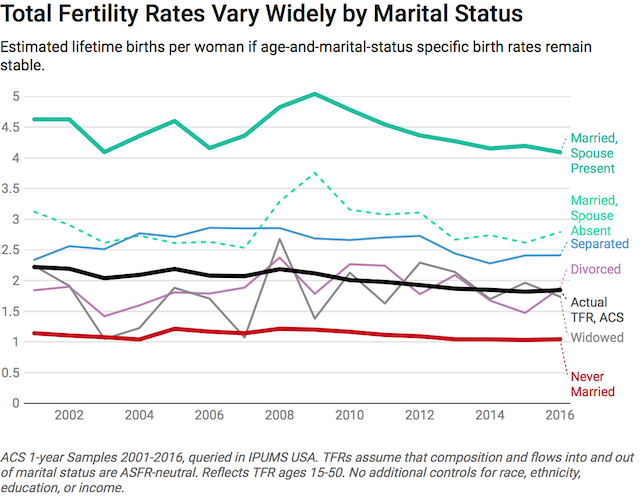
While women are married, they tend to have very high birth rates. Note that the chart above does not show that married women will have four or 5 kids; it means that the average birth rate for married women ages 15 to 50 sums up to 4 or 5 kids. But that’s a 35-year span, when the average woman will only actually spend between 12 and 20 of those years married.
As you can see above, there’s been a decline in married fertility since the peak in 2009. But married fertility rates today aren’t actually much lower than married fertility rates in the mid-2000s. For divorcees and widowers, age-adjusted birth rates are actually higher now than they were before the recession. Never married women, again, have about pre-recession levels of fertility too.
By fixing age-specific marital status to 2001 or 2008 levels, we can model a counterfactual scenario of what fertility might have been had people gotten married and formed families at the same rate as formerly.
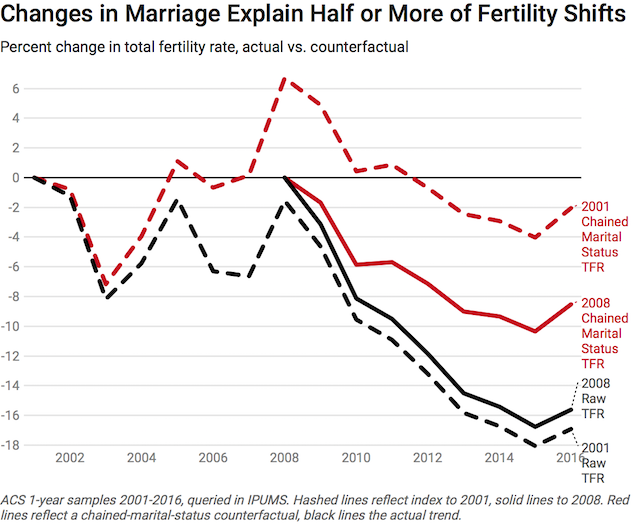
Essentially all of the decline in fertility since 2001 can be explained by changes in the marital composition of the population. Married, single, and divorced women are all about as likely, controlling for age and marital status, to have kids now as they were in 2001. But today, a smaller proportion of women are married during those peak-fertility years.
Since 2008, about half of the decline in fertility can be attributed to changes in marital composition. In other words, even if we’d had the age-and-status-chained changes in birth rates that we have actually experienced if people had just continued to get and stay married at about the rates they did in 2008, American Community Survey-measured 2016 total fertility would have been 2.0 lifetime-births per women, instead of 1.85. That’s a difference of 0.15 births per woman, or, put another way, that’s about equivalent to a very big, expensive, and successful pro-natal policy campaign.
That is to say, a ballpark estimate of the effectiveness of pro-natal policy incentives suggests it would cost about $100 to $500 billion every year for the U.S. government to offset the last 8 years or so of changes in marriage patterns.
On the other hand, this suggests a straightforward way to boost births: find a cheap way to boost marriage. So why has marriage declined?
There are many reasons young people aren’t getting married. But the most commonly cited reasons are financial need, personal unpreparedness, and lack of a suitable partner. Those last two factors speak to the role of culture. Changing cultural norms and values about sex, family, and religion may have reduced the value of the marriage proposition and tightened the criteria for “eligibility” for marriage. Maybe young people today have a stricter standard—for themselves and for others—about what constitutes readiness for marriage.
On the other hand, when cohabitation, sex, and life together are all available without the need for the legal and personal commitment of marriage, perhaps marriage itself is postponed, and, with it, childbearing. We can see this playing out in the accounts of women who would like to be married, want to have kids, and have had some serious relationships, but those just never turned into something. There just weren’t enough inducements for both parties to enact the strong commitment device of marriage.
Gallup polling gives this cultural story some weight: the share of people who thought it was important for a couple planning to spend the rest of their life together to actually get married fell from 73% in 2006 to 64% in 2013.
Marital status is a key determinant of whether or not women have as many kids as they want.
But while culture has an enormous impact on human behaviors, there are other important factors as well. Obviously, the recent economic recession had a large impact: but marriage rates still show very little sign of recovery, even after years of economic growth.
One key factor that may impact many young peoples’ behavior is school debt. A growing body of research suggests that higher levels of student debt may reduce marriage rates, especially for women. And if marriages are formed with large amounts of debt, those marriages can end up being very shaky. The same Gallup polling cited above suggests finances are a key reason young people postpone marriage.
We don’t know exactly what drives this trend. On its face, it seems ludicrous: marriage allows cost- and risk-sharing, which should make debt easier to service, so avoiding marriage due to debt seems counterproductive. But it is possible that debt may prevent marriage in various ways. High debt burdens may induce debtors to work longer hours, limiting social time for matching activities. Potential mates may view indebtedness as undesirable and avoid marrying people with lots of debt. Debt could cause elevated stress levels and diminished overall wellbeing, causing the debtor to have fewer social opportunities, or to be less pleasant a companion. Or, it may be that indebted people are made to feel inadequate due to having negative net worth, and so feel ashamed for their status, self-selecting away from marriage. We don’t know exactly how or why debt might reduce marriage, but it increasingly seems like a possible driver. There are also tax disincentives related to marriage, especially connected to student debt, but they are too modest in size to explain the scale of changes in marital behavior.
It’s possible that debt may also reduce fertility, independently of marriage. Some studies do show that student debt has a strong effect on delaying fertility. The economic rationale is simple: having and raising children costs money, and student debt gobbles up a share of income right off the top of the budget. Crucially, even income-based repayment doesn’t fix this, as it resets with higher incomes: a debtor can’t earn their way out. As income rises, so do debt payments. At some high threshold, of course, the debtor can exceed the required payments and can advance the date of final repayment, but the point is that student loans, no matter how they are structured, divert money that might have gone towards planning for a child. It’s even possible that student loans delay marriage because they cause debtors to change their childbearing anticipations: maybe debtors realize they won’t be able to afford a child for a long time, and so they postpone marriage until they are (financially) ready for a child.
This story makes sense on its face, but there is some counter-evidence as well. At least in Australia, the evidence suggests that student debt does not change childbearing expectations. Meanwhile, in the United States, controlling for marital status, it's not at all clear that higher education (thus higher exposure to indebtedness) results in a worse fertility trend.
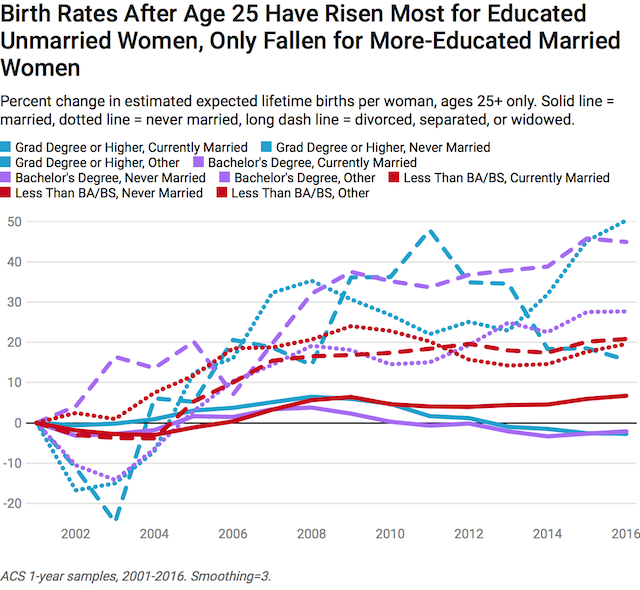
Fertility rates for non-married, educated women are rising. In fact, they are rising faster than fertility rates for non-college-attending unmarried women. Among married women, the better-educated have indeed seen a slight fertility decline, but it is very modest.
Finances, and student debt, specifically, aren’t the only reason for delayed marriage. Most unmarried people who want to get married say either that they are too young and unready for marriage, or else they haven’t found the right person. It may be that part of the problem is the decline in “marriageable men.” At the metro area level, the imbalance in sex ratios can sometimes be enormous.
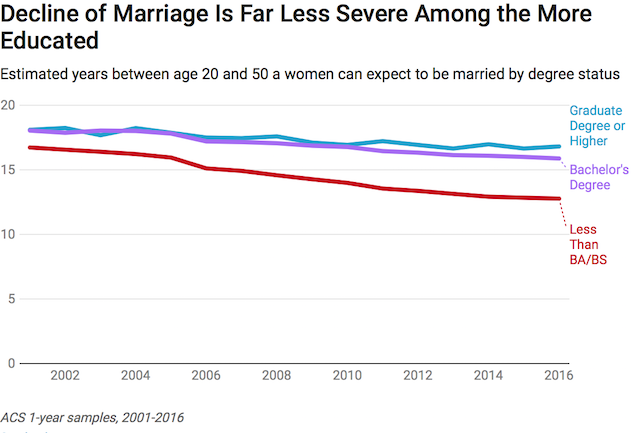
But if anything, the correlation may run the other way! Among the higher-income, better-educated groups that women demographically dominate, the average number of reproductive years a woman spends in marriage is close to stable. Marriage is mostly declining among lower-income and less-educated social groups, suggesting that, rather than a “deficiency of marriageable men” among educated women, the actual issue may be the male super-dominance of lower-education groups. Men may simply be less marriage-inclined, so where they are more numerous than women and can set cultural norms as they desire, marriage may simply be less common. Notably, this data also suggests that student debt can’t account for declining marriage on its own: marriage has declined the most among women who are less likely to have student debt.
This leads us back to cultural factors. On some level, attitudes about marriage are almost certainly playing a role. A growing share of my generation has come to believe that they do not need any formal commitment to do life together, and it’s showing up in population data.
I believe, however, that the best evidence suggests my peers will ultimately regret the slow transition into married life.
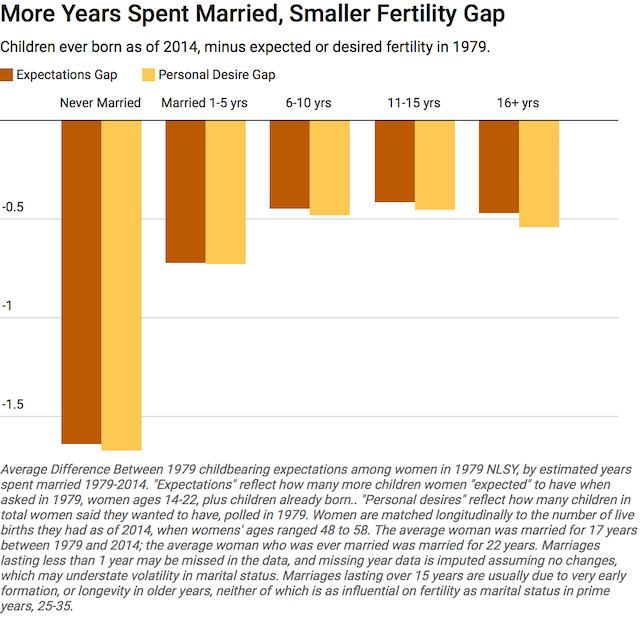
The graph above shows that women who spent fewer of their reproductive years married tended to have a bigger shortfall in births versus expectations. It turns out, not being married is closely associated with women not achieving their fertility expectations or desires. Cohabitation is not an equivalent substitute for marriage where fertility is concerned. The data presented comes from a longitudinal survey that follows a cohort of several thousand adults from young adulthood in 1979 through 2014. The results are robust and consistent whether we use fertility questions that ask about expectations, personal desires, or general ideals. For these women born around 1957-1965, not being married meant not achieving their fertility desires.
But does that hold up for later generations?
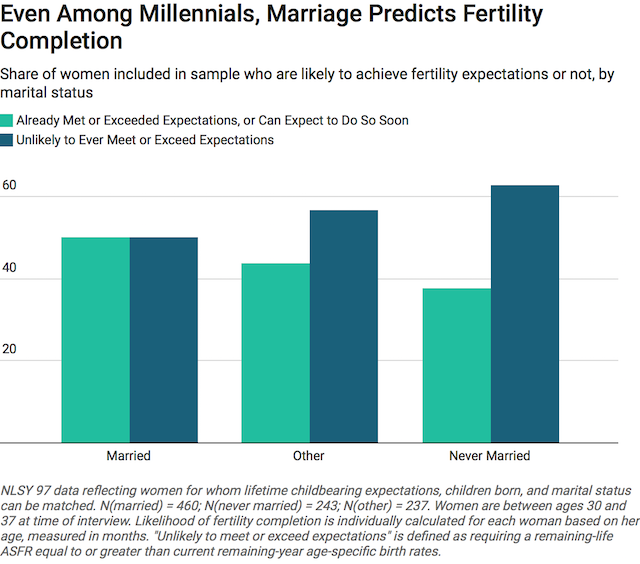
We have a second longitudinal survey following women who were born around 1980-1985, and it polls women about childbearing expectations as well. The reality is, most women in this birth cohort are well behind where they need to be to hit their fertility goals by the end of their reproductive years. For over 40% of women in this survey, they would need to reliably have more than double the recently-observed age-specific birth rates to meet their fertility expectations. That’s not likely to happen.
Among currently-married women as of 2015, probably about half will end up achieving their fertility expectations. Half won’t. Among previously-married women who were not married as of 2015, the share who are likely to undershoot desired fertility rises, and among women who have never been married, it rises even more. The simple fact of the matter is that marital status is a key determinant of whether or not women have as many kids as they want.
Finally, we can look at the General Social Survey, a large cross-sectional survey.
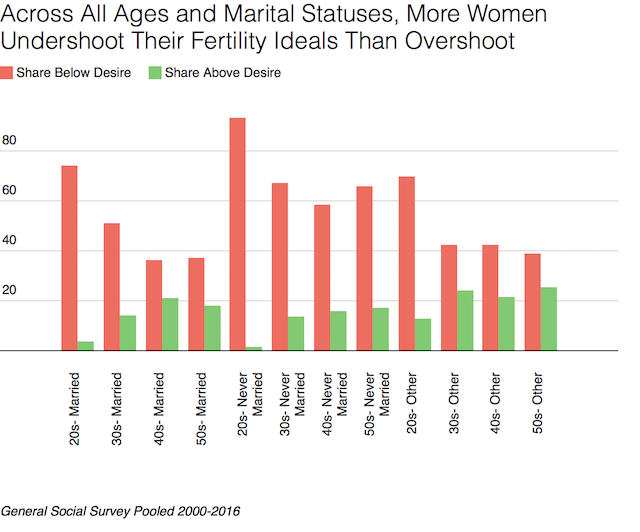
As you can see, married women were far less likely to undershoot their fertility ideals than never-married women, controlling for age. Combined, it turns out that a combination of marital status, age, and fertility ideals is a pretty good predictor of individual-level fertility. In other words, marital status serves as a circuit-breaker on fertility aims: married people get close to achieving their aims, while never-married people generally don’t.
When we think about falling fertility, there are a lot of relevant factors—from debt to childcare, housing to leave, and culture and attitudes. But one vital driver of birth rates is marriage. And as long as the average age of first marriage rises and the number of prime childbearing years the average woman spends married falls, we can expect to see fertility linger at low levels. Therefore, any policy supporting childbirth—however generous it may be—that does not also somehow impact marriage trends is unlikely to boost long-term fertility.
Lyman Stone is a Research Fellow at the Institute for Family Studies, and an International Economist at the U.S. Department of Agriculture, where he forecasts cotton market conditions. He blogs about migration, population dynamics, and regional economics at In a State of Migration.














